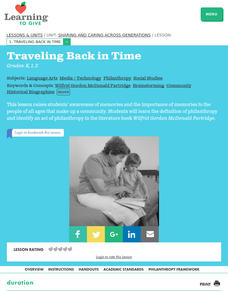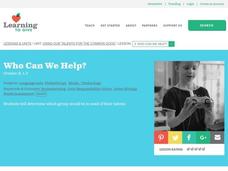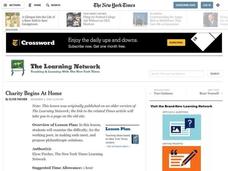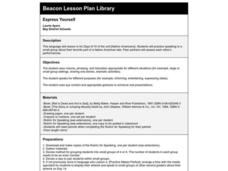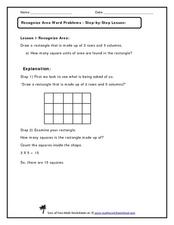Curated OER
Putting it Together: Analyzing and Producing Persuasive Text
Young orators demonstrate what they have learned about persuasion and persuasive devices throughout the unit by analyzing a persuasive speech and then crafting their persuasive essays. Class members engage in a role-play exercise, use...
Curated OER
Introduction to A Road Less Traveled
Students define philanthropy. They apply concept of philanthropy to personal experiences.
Curated OER
Traveling Back in Time
Students examine memories and the importance of memories to the people of all ages that make up a community. They explore the definition of philanthropy and identify an act of philanthropy in the literature. The book, 'Wilfrid Gordon...
Curated OER
Who Can We Help?
Students define philanthropy. For this community service lesson, students assess as a group who at school needs help. Students write letters to offer their assistance where they've found areas of need.
Curated OER
You Can Bank on Me!
Students identify reasons people choose to donate. In this donating lesson plan, students contrast the words spend, save, and donate. Students learn a song about donating, brainstorm reasons to give, and make sound choices with their money.
Curated OER
Philanthropic Movements in the United States To 1900: The Bill of Rights
Pupils translate the meanings of and draw illustrations depicting the Bill of Rights amendments. They discuss how philanthropy is enabled by the Bill of Rights.
Curated OER
Our Family
Students explore the family unit. In this family lesson, students read books about families and identify the role of each family member. Students create a family album and share their finished album with the class.
Curated OER
Counseling
Students, as a group, read a story about being kind and giving to others. They answer questions about the story and discuss it. They are also asked if it is better to have a lot of stuff or to enjoy it.
Curated OER
Sequential Directions
Students demonstrate how to give clear directions when drawing a map to a specific location. In this map skills lesson, students create a map to a location, such as their school, and write down clear directions to the destination.
Curated OER
Using Senses in My Community
Students use their senses to make observations about their community and the world. They sort and describe picture cards by senses, read a story, take a sensory walk around the school, and discuss common good.
Curated OER
What Does Christmas Mean to Me?
Students write an essay entitled "What Does Christmas Mean to Me?" In this writing lesson plan, students express their feelings about Christmas in an essay. Students discuss ways they have given to others during the Christmas season,...
Curated OER
Tell Me A Story -- Feelings
Practice using feelings as a way to reflect on past experiences. The poem The End and the text Tell Me a Story Mama are used to identify feeling words. As an extension, pupils participate in a service learning project and reflect upon...
Curated OER
Why Does Service Matter?
Students determine how community members serve others. In this service learning lesson, students interview community members who volunteer by serving others. Students then determine how they could serve their community.
Curated OER
Courage: Hero Traits
What does it mean to be a hero? Who qualifies as a hero? In groups, middle and high schoolers brainstorm a list of heroes and create a list of characteristics that a person must possess in order to be a hero. Extend this lesson by having...
Curated OER
Charity Begins At Home
Students read and discuss "Prosperity Extends Its Reach, but Not Far Enough to Benefit All," and examine the difficulty, for the working poor, in making ends meet, and propose philanthropic solutions.
Curated OER
Singing for the Animals
Students examine the correct attitudes and poster for a concert. In this "Singing for Animals" instructional activity, students created charts to diagram information about the homeless animals they were singing for. Students used correct...
Curated OER
Teaching Grammar Without the Hammer: Five Fun Activities
There are five lessons on teaching grammar here for you to peruse. Two of them work well for kindergartners; one on teaching synonyms and one on teaching parts of speech by reading Tall Tales. These lessons are especially engaging and...
Curated OER
Express Yourself
Youngsters practice retelling a part of their favorite Native American tale to a small group of their peers. Peer partners assess each others performances. To keep comments positive and constructive, consider giving your class sentence...
Curated OER
"Hard Times Come Again No More" : Letters From Arkansas Families in the Great Depression
Through this series of terrific lesson plans, pupils learn about the extent of poverty in the state of Arkansas during the Great Depression. They read documents from the period which describe how hard times were, view an online photo...
Curated OER
Women's Suffrage
Tenth graders examine the role of women in the early 1900s. In groups, they use the internet to research groups who favored or opposed giving women the right to vote. To end the instructional activity, they note the methods used by women...
Curated OER
Africa Colors a Destiny
Students discover the peace corps and the culture of Chad. In this cultural awareness activity, students watch a slide show and examine various primary sources from peace corps volunteers in Africa. This activity includes web-links,...
Curated OER
Growing in Character
Young scholars explore how to build their character by respecting and appreciating various cultures. In this character education instructional activity, students read the book Seedfolks and answer questions based on the character's...
Curated OER
What's Integrity?
Students explore the trait of integrity. In this character education lesson, students read letters by Steve Williams pertaining to jobs that help others. Students discuss the jobs WilIiams shares as well as integrity in their lives.
Math Worksheets Land
Recognizing Area Word Problems
There is only one area calculation problem here, and it is followed by a detailed explanation. Consider projecting this as a teaching tool, covering the answer until learners have shared their own. They are instructed to draw a rectangle...




